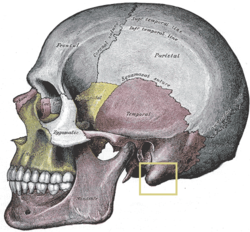Mastoid process
| Mastoid process | |
|---|---|
 Side view of head, showing surface relations of bones. (Mastoid process labeled near center.) | |
 Mastoid process | |
| Details | |
| Identifiers | |
| Latin | processus mastoideus ossis temporalis |
| Anatomical terms of bone | |
The mastoid process is a conical prominence projecting from the undersurface of the mastoid portion of the temporal bone. It is located just behind the external acoustic meatus, and lateral to the styloid process. Its size and form vary somewhat; it is larger in the male than in the female.
The term “mastoid” is derived from the Greek word for “breast,” a reference to the shape of this bone. The temporal bone contains another protrusion, the styloid process, located in close proximity to the mastoid process. The styloid process also serves as a point of attachment for muscles and has a distinctive pointed shape akin to that of a stylus, explaining the origins of the name.
This part of the skull projects from the temporal bone and is roughly pyramidal or conical in shape. One important role for this bone is as a point of attachment for several muscles - the splenius capitis, longissimus capitis, digastric posterior belly, and sternocleidomastoid. These muscles are one reason the mastoid process tends to be larger in men, because men have bigger muscles as a general rule and thus require larger points of attachment.
See also
Additional Images
-
Mastoid process
External links
- lesson5 at The Anatomy Lesson by Wesley Norman (Georgetown University)
![]() This article incorporates text in the public domain from the 20th edition of Gray's Anatomy (1918)
This article incorporates text in the public domain from the 20th edition of Gray's Anatomy (1918)

